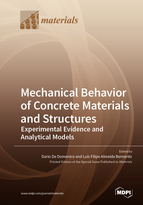Mechanical Behavior of Concrete Materials and Structures: Experimental Evidence and Analytical Models
A special issue of Materials (ISSN 1996-1944). This special issue belongs to the section "Construction and Building Materials".
Deadline for manuscript submissions: closed (20 April 2022) | Viewed by 37223
Special Issue Editors
Interests: performance-based seismic design; seismic isolation; earthquake engineering; innovative structural control systems; limit-state behavior of reinforced concrete structures; strengthening techniques of reinforced concrete structures
Special Issues, Collections and Topics in MDPI journals
Interests: structural analysis and design; numerical modelling and optimization; concrete structures; structural materials; building systems
Special Issues, Collections and Topics in MDPI journals
Special Issue Information
Dear Colleagues,
Concrete is one of the most widespread materials in the civil engineering field due to its versatility for both structural and non-structural applications depending on the density range, competitiveness in terms of durability and manufacturing costs, as well as ease in finding raw constituent elements. For this reason, the mechanical behavior of concrete and, even more, reinforced concrete has been a research theme tackled by many researchers through different approaches for years. Although the relevant literature is full of papers on this topic, ranging from experimental works to theoretical contributions, an accurate and comprehensive description of the actual mechanical behavior exhibited by concrete and reinforced concrete at service and ultimate conditions still remains a challenge in the field of structural engineering. This is due to several intricate and interconnected phenomena involved, such as tensile cracking, compression crushing, strain softening, interaction between aggregates and matrix, interaction between concrete and reinforcement, stiffness degradation, energy dissipation and ductility exhibited under cycling loading, etc.
This Special Issue aims to collect contributions that deal with the mechanical behavior of ordinary, prestressed and special concretes, including high-strength, lightweight, recycled, fiber-reinforced, and self-healing concretes, for both structural and non-structural applications. In particular, the desired topics include, but are not limited to, experimental findings, numerical approaches, and analytical models investigating the mechanical behavior of concrete, reinforced concrete and prestressed concrete members at service and/or ultimate conditions under different loading states, such as axial loads, bending, shear, torsion, or combined loading states.
Dr. Dario De Domenico
Dr. Luís Filipe Almeida Bernardo
Guest Editors
Manuscript Submission Information
Manuscripts should be submitted online at www.mdpi.com by registering and logging in to this website. Once you are registered, click here to go to the submission form. Manuscripts can be submitted until the deadline. All submissions that pass pre-check are peer-reviewed. Accepted papers will be published continuously in the journal (as soon as accepted) and will be listed together on the special issue website. Research articles, review articles as well as short communications are invited. For planned papers, a title and short abstract (about 100 words) can be sent to the Editorial Office for announcement on this website.
Submitted manuscripts should not have been published previously, nor be under consideration for publication elsewhere (except conference proceedings papers). All manuscripts are thoroughly refereed through a single-blind peer-review process. A guide for authors and other relevant information for submission of manuscripts is available on the Instructions for Authors page. Materials is an international peer-reviewed open access semimonthly journal published by MDPI.
Please visit the Instructions for Authors page before submitting a manuscript. The Article Processing Charge (APC) for publication in this open access journal is 2600 CHF (Swiss Francs). Submitted papers should be well formatted and use good English. Authors may use MDPI's English editing service prior to publication or during author revisions.
Keywords
- Concrete
- Reinforced concrete
- Prestressed concrete
- Mechanical strength
- Limit-state behavior
- Concrete structures
- Analytical models
- Experimental findings
- Service conditions
- Ultimate conditions








